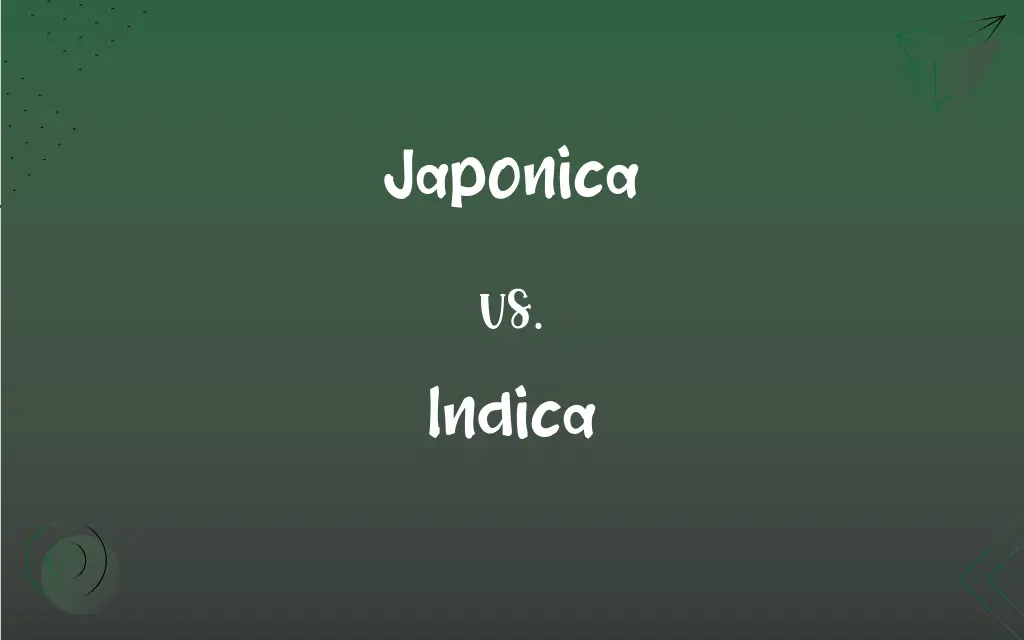Japonica vs. Indica: What's the Difference?
Edited by Janet White || By Harlon Moss || Updated on October 20, 2023
Japonica refers to short-grain, sticky rice varieties primarily grown in Japan, while indica denotes long-grain, non-sticky rice varieties grown in tropical regions.

Key Differences
Japonica and indica are two major subspecies of cultivated rice, each with distinct characteristics and growth conditions. Japonica, predominantly grown in cooler climates such as Japan, is known for its short to medium grain sizes and its stickiness when cooked. In contrast, indica, cultivated mainly in tropical regions like India, offers long, slender grains that remain separate when cooked.
The culinary applications of japonica and indica differ because of their textural variances. Japonica, being sticky, is ideal for dishes like sushi where the rice needs to hold together. Indica, on the other hand, is preferred for dishes like pilaf or biryani where the grains should stand apart.
Genetically, japonica and indica showcase distinct markers, which researchers use to differentiate and study them. While japonica strains are more genetically uniform, indica strains exhibit a wider genetic diversity, reflecting their widespread cultivation.
Agriculturally, japonica varieties often require specific cultivation techniques suited to temperate climates. These methods might not be effective for the indica varieties, which are adapted to warmer, tropical environments. It's crucial for farmers to understand these differences to ensure a successful harvest.
From a global perspective, while both japonica and indica are consumed worldwide, regional preferences exist. For instance, East Asian countries might prefer japonica for its stickiness, while many South Asian countries might opt for the fluffiness of indica.
ADVERTISEMENT
Comparison Chart
Grain Size/Shape
Short to medium grains.
Long, slender grains.
Texture when Cooked
Sticky and clumpy.
Non-sticky and separate.
Growth Conditions
Cooler, temperate climates.
Warm, tropical climates.
Primary Growing Region
Japan and parts of East Asia.
Tropical regions like India.
Genetic Diversity
More genetically uniform.
Exhibits wider genetic diversity.
ADVERTISEMENT
Japonica and Indica Definitions
Japonica
Rice primarily cultivated in cooler climates.
Japan is a leading grower of japonica varieties.
Indica
A rice variety that remains non-sticky when cooked.
Indica rice is perfect for pilafs where separated grains are desired.
Japonica
A rice variety with a more uniform genetic makeup.
Researchers have noted the genetic consistency in japonica strains.
Indica
Rice that grows predominantly in tropical regions.
India and Southeast Asia are major producers of indica rice.
Japonica
Cultivated rice preferred in many East Asian dishes.
In Japan, japonica is a staple for many traditional meals.
Indica
The preferred rice in many South Asian cuisines.
Biryani, a popular dish in India, often uses indica rice for its fluffiness.
Japonica
A subspecies of rice with short to medium grains.
Sushi often uses japonica rice because of its sticky texture.
Indica
A subspecies of rice known for its long grains.
Basmati is an example of an indica rice variety.
Japonica
A type of rice that becomes sticky when cooked.
For making onigiri, chefs usually choose japonica rice.
Indica
Rice with a broader genetic diversity than japonica.
The wide cultivation of indica has led to its varied genetic profile.
Japonica
See flowering quince.
Indica
Any of the indica subspecies of the rice, Oryza sativa, which (unlike the japonica or sinica subspecies) are non-sticky and long-grained.
Indica
Marijuana of the species Cannabis indica.
FAQs
Can japonica rice be used for sushi?
Yes, japonica's stickiness makes it ideal for sushi.
What's the primary difference in grain size between japonica and indica?
Japonica has short to medium grains, while indica has long, slender grains.
Where is indica rice mainly grown?
Indica rice is predominantly grown in tropical regions like India.
Is indica rice suitable for dishes like biryani?
Yes, the non-sticky nature of indica rice is preferred for biryani.
Which rice is more genetically diverse?
Indica rice exhibits broader genetic diversity.
Is japonica rice sticky when cooked?
Yes, japonica rice is sticky and clumpy when cooked.
Are there genetic differences between japonica and indica?
Yes, japonica is more genetically uniform, while indica shows wider diversity.
Is japonica rice also known by other names?
It might be referred to based on region, like "Japanese rice" or "Korean rice."
What dishes are best for japonica rice?
Dishes like sushi, onigiri, and risotto work well with japonica.
Why is japonica rice preferred in East Asia?
Its sticky texture makes it suitable for traditional East Asian dishes.
Is Basmati an example of indica rice?
Yes, Basmati is a type of indica rice.
Which rice is more prevalent in South Asian dishes?
Indica rice is a staple in many South Asian cuisines.
What climate is best for growing japonica?
Japonica thrives in cooler, temperate climates.
Which rice variety remains separate when cooked?
Indica rice remains non-sticky and separate when cooked.
Can indica rice be sticky?
Typically, indica rice remains non-sticky when cooked.
How are japonica and indica rice priced in the market?
Prices can vary based on variety, region, and quality, with some specialty types fetching higher prices.
Do both japonica and indica come in brown rice varieties?
Yes, both can be found in white and brown rice varieties.
Which rice is more aromatic: japonica or indica?
Some indica varieties, like Basmati and Jasmine, are known for their distinct aromas.
How does cooking method vary between japonica and indica?
Cooking methods can differ due to their distinct textures, with japonica often needing less water.
Is it possible to grow japonica in tropical regions?
It's less common due to japonica's preference for cooler climates.
About Author
Written by
Harlon MossHarlon is a seasoned quality moderator and accomplished content writer for Difference Wiki. An alumnus of the prestigious University of California, he earned his degree in Computer Science. Leveraging his academic background, Harlon brings a meticulous and informed perspective to his work, ensuring content accuracy and excellence.
Edited by
Janet WhiteJanet White has been an esteemed writer and blogger for Difference Wiki. Holding a Master's degree in Science and Medical Journalism from the prestigious Boston University, she has consistently demonstrated her expertise and passion for her field. When she's not immersed in her work, Janet relishes her time exercising, delving into a good book, and cherishing moments with friends and family.































































